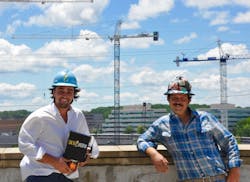23-Year-Old Invents SkyHorn Load Warning System
Robert Burke’s family has worked within the construction industry for as long as he can remember. So when the opportunity to create a worksite safety device fell into his hands, he felt a personal pull to pursue it.
“My dad has been in the construction industry for a long time, so I started working in it when I was younger,” says Burke, who at 23 was included in the 2019 Class of Under 40 in Construction Equipment. “My older brother is also a tower crane operator. [The idea] started with him wanting a way to warn folks on the job site below of when the load was coming down.”
Although a warning horn comes standard within crane cabs, Burke agreed that there was a need for a device that provided better proximal warning at the active load position. He soon began developing a device that could replace the current horn with help from his family.
“We had a lot of access to testing resources and stuff like that,” he says. “But basically, we started developing a wireless warning system called SkyHorn.”
SkyHorn mounts to a crane’s hook block. A foot pedal button allows the operator to activate the alarm as they pick up the load, swing over the deck, swing into the blind, use an outrigger, and anything in between.
“This gives operators a way to communicate warning since the load is pretty silent as it travels overhead,” Burke says. “Folks are working below, and especially with their attention down a lot of the time, you don’t even really know that there’s a 5,000-pound load above you.”
Burke says the device went through several “trial and error” phases before arriving at its final design.
“It really proved to be more difficult to do than just slapping some parts together that you buy off the shelf,” he says. “We had to make it rugged, durable, and waterproof. The construction environment really calls for that.”
As development progressed, Burke began releasing early versions of SkyHorn into the field to gain feedback, and earn revenue along the way.
“We had about 20 or 25 in the D.C. area, the first ones we were selling,” he says. “The demand was high, and the operators didn’t care for what it looked like, they just wanted one.
Having open access to job sites and gaining feedback was the most important part of the process, Burke says. Through testing, he began to take notice of situations where SkyHorn would be useful while discussing the product with operators.
“We got really great reviews from safety managers and superintendents,” he says. “With the industry’s shortage of operators we also have new workers coming in, and SkyHorn can really help. It can be reassuring and speed things up. Something that doesn’t make for extra work on the job.”
Within the last year and a half, SkyHorn has garnered interest from larger companies that usually start by installing one or two units and eventually move to four or five.
“[The increased interest] is an awesome thing to see, especially because when it was in development, sometimes it wouldn’t work or something,” he says. “But now that it’s crisp and works all the time, operators can consistently use it and get in the groove, and it’s helping.”
SkyHorn currently has about 70 units on job sites, and Burke hopes to reach between 100 and 200 units sold by next year.
“We’ve got a good number of interested companies now,” he says. “Hopefully that’ll increase into putting SkyHorn on all of their cranes and their whole fleet, because I think it could be something needed on every hook and crane. Not only tower cranes--mobile cranes and crawler cranes.
“We’ve talked with a few general contractors who have flirted with the idea to start writing it into their contracts and start requiring it so we’re hoping that one takes the leap and then we should start kind of seeing that more.”
Burke is also excited to get SkyHorn “out there,” and to keep pushing the idea behind it.
“The cool part is when I ride the Metro next to a job around here and I start hearing them,” he says. “I’m not even technically there to see it or install one, but I can hear it when I’m walking by. They’re using it and I'm helping in a certain way. It’s very cool.”
Visit the SkyHorn website here.
About the Author
Gianna Annunzio
Gianna was associate editor from 2018 - 2021.
